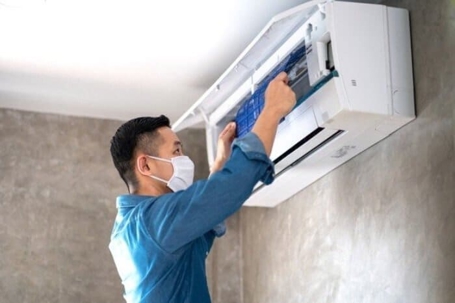Maintaining a comfortable indoor environment is crucial, especially during the sweltering summer months. A properly functioning air conditioning (AC) system is a primary component in achieving this comfort. However, regular use can lead to wear and tear, requiring timely repairs to ensure efficiency and comfort. This comprehensive guide will delve into the importance of AC repair, provide an overview of AC Repair Carter Heat & Air, and provide essential information every homeowner should know about maintaining their AC system.
Importance of AC Repair
Air conditioning systems are pivotal in regulating indoor temperatures and humidity levels. A functioning AC unit keeps spaces cool, ensuring comfort for occupants. Regular maintenance and timely repairs help prevent more significant issues down the line, which can disrupt cooling capabilities and result in increased energy costs. When ignored, seemingly minor problems can develop into substantial repairs that may also impact the overall air quality in your home.
AC Repair Carter Heat & Air provides the necessary services to ensure your AC system operates at peak performance, safeguarding your comfort throughout the warmer months.
Overview of Carter Heat & Air Services
Carter Heat & Air offers various services designed to address all aspects of air conditioning care. These services include:
- Comprehensive AC repair and diagnostics
- Routine maintenance and tune-ups
- Emergency repair services
- Installation of new AC systems
- Guidance on energy efficiency and system upgrades
This inclusive approach ensures homeowners can access the necessary support and services to maintain their HVAC systems effectively.
Understanding AC Systems
Key Components of an AC Unit
To appreciate the significance of AC repair, it is essential to understand the fundamental components of an air conditioning system. The main parts of an AC unit include:
- Compressor: This component circulates refrigerant throughout the system, compressing it to raise its temperature and pressure.
- Condenser: Located outside your home, the condenser releases heat absorbed from the inside. It transforms the refrigerant from a gas back into a liquid.
- Evaporator: The refrigerant evaporates in the evaporator coil, absorbing heat from the indoor air and cooling the space.
- Expansion Valve: This valve regulates refrigerant flow into the evaporator, maintaining the necessary pressure for efficient cooling.
Understanding these components can help homeowners recognize the importance of maintaining them and the consequences of neglect.
How Air Conditioning Works
The primary function of an AC unit is to regulate temperature and humidity. The refrigeration cycle is at the heart of this process, which involves the following steps:
- The compressor pressurizes the refrigerant, turning it into a hot gas.
- The gas travels to the condenser, releasing heat and transforming into a liquid.
- The liquid refrigerant flows through the expansion valve, where it experiences a pressure drop and cools further.
- The cold refrigerant enters the evaporator, absorbing heat from the indoor air. This cools the air, which is then circulated back into the living space.
Airflow is vital in this process. Proper airflow is necessary to distribute the cooled air effectively, and blockages can significantly affect the system’s overall efficiency.
Recognizing AC Issues
Common Signs Your AC Needs Repair
Recognizing the signs of AC trouble early can save homeowners from costly repairs and ensure comfort during hot weather. Common indicators that your AC requires attention include:
- Warm Air from Vents: If your air conditioning system blows warm air, it may signal a refrigerant leak or compressor issue.
- Unusual Sounds and Smells: Strange noises such as buzzing or grinding can indicate mechanical problems. Unpleasant odors may point to electrical issues or mold growth.
- High Humidity Levels Indoors: An AC unit should regulate indoor humidity. If your home feels muggy or clammy, it may not function correctly.
Importance of Early Diagnosis
Early diagnosis of AC issues is crucial for several reasons. Ignoring problems can lead to further damage, resulting in higher repair costs. Additionally, a malfunctioning AC system can increase energy bills as the unit works harder to compensate for underlying issues. Prompt repairs not only restore comfort but can also prolong the life of your system.
Types of AC Repairs
Refrigerant Leaks
Refrigerant leaks are a common issue in AC systems that require immediate attention. Signs of a leak may include a decline in cooling performance or ice buildup on the evaporator coil. Detecting leaks typically involves checking the refrigerant lines for bubbles or moisture and utilizing special dyes to trace the refrigerant.
Repairing a refrigerant leak often involves sealing the leak and refilling the refrigerant. Costs can vary based on the extent of the leak and the amount of refrigerant required for the repair.
Electrical Problems
Electrical issues can also disrupt AC performance. Common problems include blown fuses, tripped circuit breakers, and malfunctioning thermostats. Identifying electrical malfunctions is critical, and preventive measures such as regular inspections can help mitigate risks.
Standard fixes for electrical problems may involve replacing fuses, resetting breakers, or replacing faulty thermostats.
Thermostat Issues
The thermostat is crucial for regulating your HVAC system’s temperature settings. Malfunctioning thermostats can lead to inconsistent temperatures and increased energy usage. Common problems include incorrect settings, dead batteries, or sensor issues.
If your thermostat is not functioning correctly, troubleshooting often entails checking settings, replacing batteries, or recalibrating the device. In some cases, replacement may be necessary.
Drainage and Water Issues
Clogged drainage systems can pose significant issues for AC units. Water accumulation due to a clog can lead to mold growth, water damage, and increased humidity levels. Routine maintenance can prevent these clogs, often caused by dirt and debris buildup.
Solutions for drainage issues usually involve cleaning the drain line and ensuring that the condensate pan is free from obstructions. Regular system maintenance can reduce the likelihood of these problems.
The AC Repair Process
Initial Inspection and Diagnostics
When contacting Carter Heat & Air for AC repair, expect an initial inspection and diagnostic process. Technicians will assess the system, check for observable issues, and utilize diagnostic tools such as refrigerant gauges, multimeters, and thermographic cameras.
This thorough evaluation allows service providers to pinpoint the specifics of the problem, leading to effective repairs.
Repair Procedures
Repair processes may vary depending on the issue at hand. Common procedures include:
- Replacing faulty parts or components, such as capacitors or contactors.
- Sealing refrigerant leaks.
- Cleaning or replacing clogged filters.
- Adjusting or replacing thermostats.
Timeframes for various repairs can range from a few hours for simple tasks to a day or more for extensive replacements. Prioritizing regular maintenance can minimize repair frequency and duration.
Professional AC Repair Services
Choosing the Right Technician
Selecting the right technician for AC repairs is critical to ensuring quality service. Homeowners should look for affordable HVAC service providers with recognized credentials, such as licenses and certifications.
Considering customer reviews and referrals is also beneficial when choosing a repair service. Positive feedback from previous clients can provide insight into a company’s reliability and quality of service.
Cost of AC Repairs
Understanding the typical costs associated with AC repairs helps homeowners budget effectively. Average pricing varies based on the type of repair and region but typically includes the cost of labor, replacement parts, and materials.
Service estimates should be clear and detailed, helping customers understand the necessary repairs and associated costs. Always request estimates before initiating any work.
DIY AC Maintenance
Routine Maintenance Tips
Routine maintenance is essential for keeping AC systems running smoothly. Homeowners can perform several DIY tasks, including:
- Regularly replace air filters every 30 to 45 days.
- Cleaning the condenser coils to improve efficiency.
- Ensuring precise airflow around the exterior unit and adjusting landscaping to avoid obstructions.
Seasonal Preparation for AC Units
Preparing your AC unit for seasonal changes is vital for optimal performance. Before summer use, ensure that all systems are operational and the unit is debris-free. During winter, consider winterizing your AC system by covering outdoor units to protect them from the elements.
Investing time in regular maintenance can prolong the lifespan of your AC unit and improve its efficiency.
Common FAQs About AC Repair
What should I do if my AC stops working suddenly?
If your AC unit suddenly stops functioning, check your thermostat settings, confirm the power supply is operational, and ensure the circuit breaker has not tripped. If the issue persists, contact a professional technician.
How frequently should I service my AC unit?
Regular servicing is recommended at least once a year, preferably before the heating or cooling seasons. More frequent service may be necessary in high-usage scenarios.
What are the most common issues that require repairs?
The most common problems include refrigerant leaks, electrical malfunctions, thermostat issues, and drainage clogs.
Can I fix my AC myself, or should I call a professional?
DIY repairs can be tempting, but many AC issues require professional assistance to ensure safety and proper functioning. When in doubt, consult an experienced technician.

